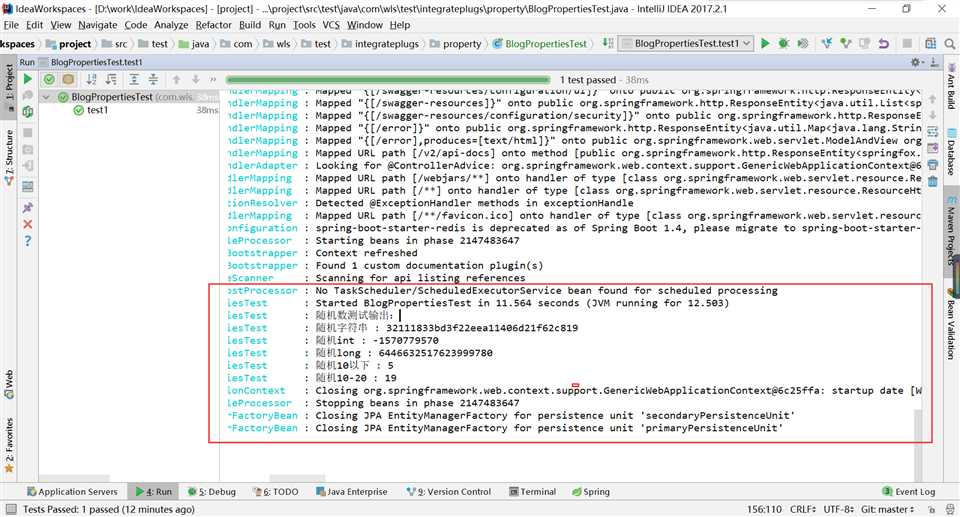标签:配置文件 环境配置 总结 安全 就会 分享 测试环境 org 令行
我们在使用Spring Boot的时候,通常也需要定义一些自己使用的属性,我们可以如下方式直接定义:
application-dev.yml
com.didispace.blog:
name: 程序猿DD
title: Spring Boot教程
desc: ${com.didispace.blog.name}正在努力写《${com.didispace.blog.title}》
# 随机字符串
value: ${random.value}
# 随机int
number: ${random.int}
# 随机long
bignumber: ${random.long}
# 10以内的随机数
test1: ${random.int(10)}
# 10-20的随机数
test2: ${random.int[10,20]}
package com.wls.integrateplugs.property;
import org.springframework.beans.factory.annotation.Value;
import org.springframework.stereotype.Component;
/**
* @author 程序猿DD
* @version 1.0.0
* @date 16/5/5 下午12:16.
* @blog http://blog.didispace.com
*/
@Component
public class BlogProperties {
@Value("${com.didispace.blog.name}")
private String name;
@Value("${com.didispace.blog.title}")
private String title;
@Value("${com.didispace.blog.desc}")
private String desc;
@Value("${com.didispace.blog.value}")
private String value;
@Value("${com.didispace.blog.number}")
private Integer number;
@Value("${com.didispace.blog.bignumber}")
private Long bignumber;
@Value("${com.didispace.blog.test1}")
private Integer test1;
@Value("${com.didispace.blog.test2}")
private Integer test2;
public String getName() {
return name;
}
public void setName(String name) {
this.name = name;
}
public String getTitle() {
return title;
}
public void setTitle(String title) {
this.title = title;
}
public String getDesc() {
return desc;
}
public void setDesc(String desc) {
this.desc = desc;
}
public String getValue() {
return value;
}
public void setValue(String value) {
this.value = value;
}
public Integer getNumber() {
return number;
}
public void setNumber(Integer number) {
this.number = number;
}
public Long getBignumber() {
return bignumber;
}
public void setBignumber(Long bignumber) {
this.bignumber = bignumber;
}
public Integer getTest1() {
return test1;
}
public void setTest1(Integer test1) {
this.test1 = test1;
}
public Integer getTest2() {
return test2;
}
public void setTest2(Integer test2) {
this.test2 = test2;
}
}
按照惯例,通过单元测试来验证BlogProperties中的属性是否已经根据配置文件加载了。然后通过@Value("${属性名}")注解来加载对应的配置属性,具体如下:
package com.wls.test.integrateplugs.property;
import com.wls.integrateplugs.property.BlogProperties;
import org.apache.commons.logging.Log;
import org.apache.commons.logging.LogFactory;
import org.junit.Assert;
import org.junit.Test;
import org.junit.runner.RunWith;
import org.springframework.beans.factory.annotation.Autowired;
import org.springframework.boot.test.context.SpringBootTest;
import org.springframework.test.context.junit4.SpringJUnit4ClassRunner;
/**
*
* @author 程序猿DD
* @version 1.0.0
* @blog http://blog.didispace.com
*
*/
@RunWith(SpringJUnit4ClassRunner.class)
@SpringBootTest
public class BlogPropertiesTest {
private static final Log log = LogFactory.getLog(BlogPropertiesTest.class);
@Autowired
private BlogProperties blogProperties;
@Test
public void test1() throws Exception {
Assert.assertEquals("程序猿DD", blogProperties.getName());
Assert.assertEquals("Spring Boot教程", blogProperties.getTitle());
Assert.assertEquals("程序猿DD正在努力写《Spring Boot教程》", blogProperties.getDesc());
log.info("随机数测试输出:");
log.info("随机字符串 : " + blogProperties.getValue());
log.info("随机int : " + blogProperties.getNumber());
log.info("随机long : " + blogProperties.getBignumber());
log.info("随机10以下 : " + blogProperties.getTest1());
log.info("随机10-20 : " + blogProperties.getTest2());
}
}

在application.properties中的各个参数之间也可以直接引用来使用,就像下面的设置:
com.didispace.blog.name=程序猿DD
com.didispace.blog.title=Spring Boot教程
com.didispace.blog.desc=${com.didispace.blog.name}正在努力写《${com.didispace.blog.title}》
com.didispace.blog.desc参数引用了上文中定义的name和title属性,最后该属性的值就是程序猿DD正在努力写《Spring Boot教程》。
在一些情况下,有些参数我们需要希望它不是一个固定的值,比如密钥、服务端口等。Spring Boot的属性配置文件中可以通过${random}来产生int值、long值或者string字符串,来支持属性的随机值。
# 随机字符串
com.didispace.blog.value=${random.value}
# 随机int
com.didispace.blog.number=${random.int}
# 随机long
com.didispace.blog.bignumber=${random.long}
# 10以内的随机数
com.didispace.blog.test1=${random.int(10)}
# 10-20的随机数
com.didispace.blog.test2=${random.int[10,20]}
相信使用过一段时间Spring Boot的用户,一定知道这条命令:java -jar xxx.jar --server.port=8888,通过使用–server.port属性来设置xxx.jar应用的端口为8888。
在命令行运行时,连续的两个减号--就是对application.properties中的属性值进行赋值的标识。所以,java -jar xxx.jar --server.port=8888命令,等价于我们在application.properties中添加属性server.port=8888,该设置在样例工程中可见,读者可通过删除该值或使用命令行来设置该值来验证。
通过命令行来修改属性值固然提供了不错的便利性,但是通过命令行就能更改应用运行的参数,那岂不是很不安全?是的,所以Spring Boot也贴心的提供了屏蔽命令行访问属性的设置,只需要这句设置就能屏蔽:SpringApplication.setAddCommandLineProperties(false)。
我们在开发Spring Boot应用时,通常同一套程序会被应用和安装到几个不同的环境,比如:开发、测试、生产等。其中每个环境的数据库地址、服务器端口等等配置都会不同,如果在为不同环境打包时都要频繁修改配置文件的话,那必将是个非常繁琐且容易发生错误的事。
对于多环境的配置,各种项目构建工具或是框架的基本思路是一致的,通过配置多份不同环境的配置文件,再通过打包命令指定需要打包的内容之后进行区分打包,Spring Boot也不例外,或者说更加简单。
在Spring Boot中多环境配置文件名需要满足application-{profile}.properties的格式,其中{profile}对应你的环境标识,比如:
application-dev.properties:开发环境application-test.properties:测试环境application-prod.properties:生产环境至于哪个具体的配置文件会被加载,需要在application.properties文件中通过spring.profiles.active属性来设置,其值对应{profile}值。
如:spring.profiles.active=test就会加载application-test.properties配置文件内容
下面,以不同环境配置不同的服务端口为例,进行样例实验。
针对各环境新建不同的配置文件application-dev.properties、application-test.properties、application-prod.properties
在这三个文件均都设置不同的server.port属性,如:dev环境设置为1111,test环境设置为2222,prod环境设置为3333
application.properties中设置spring.profiles.active=dev,就是说默认以dev环境设置
测试不同配置的加载
java -jar xxx.jar,可以观察到服务端口被设置为1111,也就是默认的开发环境(dev)java -jar xxx.jar --spring.profiles.active=test,可以观察到服务端口被设置为2222,也就是测试环境的配置(test)java -jar xxx.jar --spring.profiles.active=prod,可以观察到服务端口被设置为3333,也就是生产环境的配置(prod)按照上面的实验,可以如下总结多环境的配置思路:
application.properties中配置通用内容,并设置spring.profiles.active=dev,以开发环境为默认配置application-{profile}.properties中配置各个环境不同的内容
Spring Boot? 配置文件详解:自定义属性、随机数、多环境配置等
标签:配置文件 环境配置 总结 安全 就会 分享 测试环境 org 令行
原文地址:http://www.cnblogs.com/wlsblog/p/7487325.html